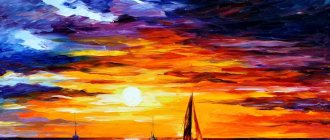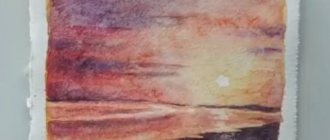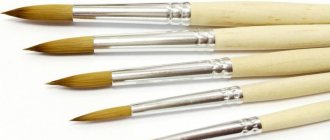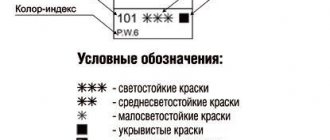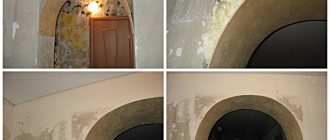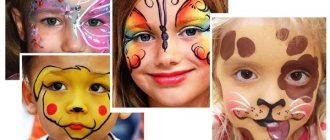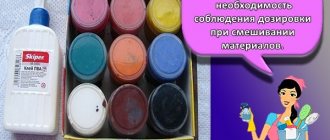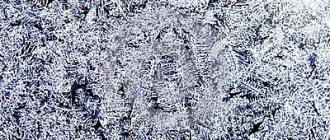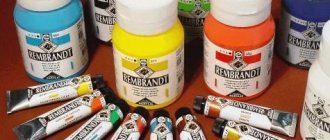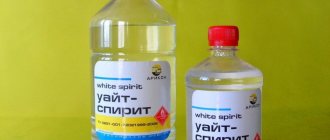Many people like to visit art galleries and exhibitions, and get acquainted with works of art on the Internet. Most of them don’t even dream of learning how to draw the same way. Others allow themselves not only to dream about it, but also take the first steps towards mastering initial skills. For contemporary artists, there are a huge number of different materials. Today we will talk about gouache.
Nowadays, this paint is often perceived only as a material for children's creativity or decoration. However, professional artists create beautiful and unique gouache paintings. The landscapes, especially at dusk and dawn, are magnificent.
If you want to learn how to draw and have some free time, start studying at a private art school. Gouache painting lessons can also be found on the global network; many professionals and amateurs share their experiences on the Internet. This article is intended for beginner artists; it will give a general idea of gouache, drawing techniques and the features of working with paint.
What is gouache?
The composition of this paint includes ground pigments, a water-based adhesive base and white.
A gouache painting can be painted on paper, plywood, glass, fabric - paint adheres well to these materials. Working with gouache is convenient because there is no need to purchase various auxiliary products: special thinners, accelerators or drying retardants. In addition, it does not have a specific odor, you do not need to use a solvent when working, and changes to the painting are possible even after some time has passed.
The main difference between gouache and watercolor is that watercolor is usually applied in several layers, so you can play with the final result. With gouache, applying several layers of paint does not make sense, because the human eye in the picture will only see a layer of gouache applied on top of the rest.
Gouache drawing lessons. How to choose gouache?
There are the following types of gouache:
- Artistic gouache, for working with which uncoated cardboard, watercolor and tinted paper are suitable as a surface. The paint is ground pigments with the addition of water, white and gum arabic.
- Poster gouache is different in that it is produced using kaolin instead of white. This makes the paint denser and the colors applied brighter.
- A special gouache for children's creativity contains PVA glue, which replaces the more expensive gum arabic. This composition allows the paint to dry faster, crumble and wear less. With the help of children's gouache you can paint on paper and plywood, on ceramic products and canvas without primer.
- Acrylic gouache is used for painting all possible surfaces, and after drying it is not washed off with water.
Secrets of working with gouache
In order for a gouache painting to turn out no worse than a watercolor painting, you must follow some rules:
- You need to paint from dark to light, that is, dark tones of paint are applied first and only then highlights are drawn and color accents are placed.
- A special color wheel used by most artists will help you mix colors and shades. Colors adjacent in sectors, when mixed, give a color without dirt. For drawing shadows, a color from the opposite sector is best suited. To depict shadows, you can use green, blue and purple colors, but black is not suitable for this purpose. Also, this color is completely unsuitable for obtaining a darker shade, since in this case the gouache painting will look dirty.
- If you make a blot, you can correct it only after the gouache has completely dried, otherwise you will get a dirty stain. To correct the error, the brush is moistened in warm, clean water and lightly wiped. Then you can carefully wipe off excess paint with it or shade the too clear outline of an object.
- Gouache becomes lighter as it dries, so when choosing a color, give preference to a brighter one in order to ultimately get the result you planned.
Summer motif in the landscape
Residential houses with a garden are often added to the depiction of nature. Since in the summer many city residents go out to relax and admire the countryside. Simple step-by-step instructions are suitable even for children.
Work plan:
- A horizon line is drawn separating the sky from the earth;
- Clouds and the sun are drawn from above;
- On the left, tree trunks are drawn in the foreground;
- The branches are being drawn;
- The crown of the trees is drawn according to the type of clouds, so that there is splendor;
- An eraser is always at hand to clean up the necessary areas;
- There will be a house on the right, you need to remember how to beautifully draw its details;
- Two rectangles are drawn, with a roof on top of them.
Next you should start drawing specific details: a pipe on the roof, windows, a door. Extra lines are erased.
You can draw a picket fence from the house, through which the grass can be seen. The resulting drawing can be left as is, or you can decorate it.
Choosing a brush for painting with gouache
Brushes that are too soft are not suitable for working with gouache. For shading, backgrounds and fills when working with a damp brush, kolinsky, goat and synthetics are perfect.
For objects with a textured surface and when working with three-dimensional images, it is best to use a dry brush with hog bristles.
To depict a complex structure, you can also use a foam sponge, special rollers and ordinary paper napkins instead of a brush. With their help, you can achieve maximum realism by drawing the roughness of ceramic products or drawing a still life.
How to create a background for gouache?
Two methods are used to draw the background:
- The artist makes a pencil sketch and then fills in the outlines, starting with the dark elements. The contour is filled without pressing from the edge to the center, then from the center to the other edge. The consistency of thin sour cream can serve as a guide to determining the desired thickness of paint. This method is suitable for working with a small pattern.
- If the surface is large, then it is better to use the filling method, when the background is painted first, and only then the details are drawn. Most often, the background consists of two or three colors. For a landscape, for example, the color of the sky is used in the upper part of the picture, the color of the earth in the lower part, and the lightest stripe is applied in the middle.
Then, before the paint dries, the background is smoothed with a wide, damp brush, continuously from left to right, moving from the bottom of the picture to the top. After this, the brush is wetted again and the paint is smoothed, moving vertically from top to bottom. This method may seem quite complicated, but this is the only way the gouache painting will have an even and beautiful background. Next, details of the landscape (for example, hills) are drawn on the still wet background, and after the paint has dried, vegetation, clouds and other planned elements of the composition are painted. For convenience, the paper should be well secured to the tablet.
Memories of Summer
Yellow colorful sunflowers in a vase are the embodiment of warm summer days.
This picture lifts your spirits on any day.
To create flowers on paper with gouache for beginners, you need to follow the tips step by step:
- Make a pencil sketch, schematically indicate the direction of the stem, leaves, petals.
- Prepare gouache “Master Class 12 Colors” by selecting the desired shades.
- Paint the petals with a thin brush and allow time to dry.
- Draw a vase in the same way, noting its lines, dimensions and base.
- Schematically divide the vase into three even parts.
- Create the bases of the oval, combining them into one large one.
- Paint the vase with colored paints.
It is important to know: it is not necessary to buy a large number of gouache shades. Buy: white, black, blue, yellow, red, brown. Other colors are created by mixing primary colors.
The result is a worthy picture that decorates the room. You can draw any flower arrangements, bouquets. In art lessons, children often draw flowers. This is the simplest option on which you can practice the subtleties of gouache painting techniques.
Step-by-step methods will help even children understand the basics of drawing. The ability to carry out sequential actions, choose paints and brushes will help reflect the natural beauty on the canvas.
The depiction of a landscape in gouache begins with a pencil sketch of the drawing diagram. It's easier to start from the top of the picture, with the blue sky, then move on to the white clouds. Clouds are painted with whitewash, waving the brush across the sky.
Mountains are depicted with brown colors, plants with green colors. The main condition is to choose colors that look realistic. Sometimes the paints are mixed on a sheet, changing the water frequently. After finishing the work, let the painting dry and varnish.
Once you understand the process and techniques of painting with gouache, you can achieve success in the fine arts. Moving step by step, beginning masters master skills gradually.
In addition, drawing is a useful activity for developing imagination and thinking. While a person is drawing, he feels calm, peaceful, immerses himself in another world, forgets about troubles and problems.
Looking at the paintings of famous artists, you involuntarily admire their creativity and ability to depict the world around them in bright colors. Each of us can also try to master the art of drawing and make this hobby our favorite pastime. Here are beautiful gouache drawings for beginners; they will allow you to test your talent in painting and master the technique of painting with paints.
Gouache painting techniques
You can use various painting techniques when painting with gouache. The following techniques are suitable for beginners:
- Glaze. With this method, translucent layers of other shades are applied on top of the main color, resulting in a new, deeper color. Translucency is achieved by diluting the paint with water. This technique is great for depicting fog.
- Pastose technique. This method involves applying thick, undiluted gouache to the surface. In this style, it is most convenient to work with children's and acrylic gouache, since they do not crack or crumble.
- Sgraffito is a gouache technique in which light paint is first applied to the surface, and after drying, a thick layer of dark-colored gouache is applied. When it dries, using a drawing pen, a stylus and a thick needle, a design is created by removing the top dry, but still fresh, layer of dark paint.
- Mixed technique, in which the background, for example, is painted in gouache, and the elements of the composition are applied with acrylic paint.
Beautiful drawings with paints on paper, sketches for girls
In this section I would like to provide several interesting templates or samples that can be used for sketching.
The simplest drawing that can be drawn with any colors.
Another portrait, also painted.
A good option that you can draw in your album is an eye, for example, like this.
Above is an example of a night landscape.
A night view is also offered here.
With the silhouette of a cat.
Another interesting option for an evening seascape with a dolphin.
You can draw portraits of people, but drawings of animals are no less interesting. For example, this is a fairly simple portrait of an owl to draw.
Here's another interesting option. A girl is under an umbrella, and a rainbow is pouring from the sky as rain. Very original.
Previously, personal diaries were very popular among girls, where they drew a lot. Maybe someone is still engaged in such diaries. Then the drawings given here will come in handy.
For example, here is a night drawing with a cat sitting on a branch.
And if you have your own favorite pet, then you can try to draw such a portrait of it.
Of course, it is a little complicated compared to the previous ones, but with patience you can draw it too.
But this drawing is simple in terms of execution technique, so it will not be difficult to draw it.
I hope you will like the drawings given here and try to draw them. And if you experiment a little, you can add something of your own to them.
You can draw such interesting and simple drawings using watercolor or gouache either independently or together with your children. Try to create and share what you come up with.
Step-by-step painting with gouache
Let's look at a simple example of how to draw pictures with gouache. We will gradually perform one step after another in order to draw a tree:
- Since we are planning to draw a tree on a winter day, we will first paint a background of snow and sky. In the place where you plan to draw a tree, we recommend highlighting the sky with a brighter color, since the white branches dusted with snow should be clearly visible against its background.
- After the background has dried, use a simple pencil or immediately paint a dark shade to draw a tree with branches.
- We continue to work on the tree: draw brown branches near the trunk and white thin branches at the ends.
- After this, it is necessary to detail the tree itself and the white branches.
- Since the background of sky and snow itself looks a bit boring, we introduce additional colors. You can, for example, add a little light pink, lilac or peach shade to the background. This will enliven our drawing and make it more interesting.
As you can see, even a not very experienced artist can paint such a simple picture. You just need to have paint, a piece of paper, a brush, water on hand and, of course, a strong desire to learn how to draw.
Additional recommendations
A step-by-step method helps even children understand the basics of painting with gouache. Such lessons will allow you to master this wonderful creativity and learn how to paint in a certain sequence, choose the right paints to reflect the real beauty of nature, representatives of the flora and fauna on canvas.
To create pictures of nature, like drawings on any other topic, you need to start with a pencil sketch. It's easiest to draw by starting at the top of the canvas or piece of paper. As a rule, at the top is the sky, which is colored blue along the pencil contours.
Clouds are painted with whitewash, brushing white highlights across the blue sky.
Mountains are depicted in brown colors, and vegetation in green tones. The trees below are depicted in lighter or darker green gouache. The main thing is that the colors in the painting look like in reality. Paints can be mixed directly on the sheet, changing the water periodically. To create fine lines, you need to choose the right brush.
When using gouache, you must adhere to the following tips:
- You can buy gouache in tubes or jars; everyone chooses the most convenient packaging for themselves.
- The colors you need to choose are those that will be needed to work on the painting.
- Tests should be done on the palette, only after selecting the desired color, transfer it to the canvas.
- If the paint cracks, add a little gum arabic to it and stir thoroughly.
- To apply the next layer, you need to wait until the previous one has dried.
- It is advisable to coat the painting with varnish after drying.
Having mastered the technique of drawing, you can achieve success in artistic creativity. Moving step by step, from simple to complex, beginning artists gradually master the technique of painting with gouache. Below are video tutorials, the purpose of which is to help you depict the chosen plot on the canvas as accurately as possible. This step-by-step approach allows you to quickly learn how to work with paints such as gouache.
Gouache painting lessons for beginners (2 videos)
Many people like to visit art galleries and exhibitions, and get acquainted with works of art on the Internet. Most of them don’t even dream of learning how to draw the same way. Others allow themselves not only to dream about it, but also take the first steps towards mastering initial skills. For contemporary artists, there are a huge number of different materials. Today we will talk about gouache.
If you want to learn how to draw and have some free time, start studying at a private art school. Gouache painting lessons can also be found on the global network; many professionals and amateurs share their experiences on the Internet. This article is intended for beginner artists; it will give a general idea of gouache, drawing techniques and the features of working with paint.
